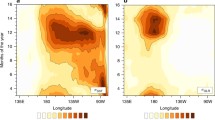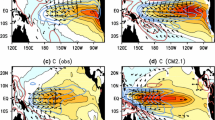Abstract
Extraordinarily strong El Niño events, such as those of 1982/1983 and 1997/1998, cause havoc with weather around the world, adversely influence terrestrial and marine ecosystems in a number of regions and have major socio-economic impacts. Here we show by means of climate model integrations that El Niño events may be boosted by global warming. An important factor causing El Niño intensification is warming of the western Pacific warm pool, which strongly enhances surface zonal wind sensitivity to eastern equatorial Pacific sea surface temperature anomalies. This in conjunction with larger and more zonally asymmetric equatorial Pacific upper ocean heat content supports stronger and longer lasting El Niños. The most intense events, termed Super El Niños, drive extraordinary global teleconnections which are associated with exceptional surface air temperature and rainfall anomalies over many land areas.







Similar content being viewed by others
References
Aceituno P et al (2008) The 1877–1878 El Niño episode: associated impacts in South America. Clim Chang 92:389–416
Bayr T et al (2014) The eastward shift of the Walker Circulation in response to global warming and its relationship to ENSO variability. Clim Dyn 43:2,747–2,763
Bellenger H et al (2014) ENSO representation in climate models: from CMIP3 to CMIP5. Clim Dyn 42:1,999–2,018
Cai W et al (2003) Strong ENSO variability and a Super-ENSO pair in the CSIRO mark3 coupled climate model. Mon Weather Rev 131:1,189–1,210
Cai W et al (2014) Increasing frequency of extreme El Niño events due to greenhouse warming. Nat Clim Chang 4:111–116. doi:10.1038/nclimate2100
Cai W et al. (2015) Increasing frequency of extreme La Niña events induced by greenhouse warming. Nat Clim Chang 5: doi: 10.1038/NCLIMATE2492
Collins M et al (2010) The impact of global warming on the tropical Pacific Ocean and El Niño. Nat Geosci 3:391–397
Davis M (2001) Late Victorian Holocausts: El Niño famines and the making of the third world. Verso, London
Diaz HF, McCabe GJ (1999) A possible connection between the 1878 yellow fever epidemic in the southern United States and the 1877–78 El Niño episode. Bull Am Meteorol Soc 80:21–27
DiNezio PN et al (2009) Climate response of the equatorial pacific to global warming. J Clim 22:4873–4892
England MH et al (2014) Recent intensification of wind-driven circulation in the Pacific and the ongoing warming hiatus. Nature 4:222–227. doi:10.1038/nclimate2106
Fedorov AV, Philander SG (2000) Is El Niño changing? Science 288:1997–2002
Fedorov AV et al (2006) The Pliocene paradox (mechanisms for a permanent El Nino). Science 312:1485–1489
Fedorov AV et al (2013) Patterns and mechanisms of early Pliocene warmth. Nature 496(43):43–49
Frauen C, Dommenget D (2010) El Niño and La Niña amplitude asymmetry caused by atmospheric feedbacks. Geophys Res Lett 37:L1880. doi:10.1029/2010GL044444
Fu R et al (1992) Cirrus-cloud thermostat for tropical sea-surface temperatures tested using satellite data. Nature 358:394–397
Galeotti S et al (2010) Evidence for active El Nino Southern Oscillation variability in the Late Miocene greenhouse climate. Geology 38:419–422
Grodsky SA, Carton JA (2001) Intense surface currents in the tropical Pacific during 1996–1998. J Geophys Res 106(C8):16,673–16,684
Hong LC, LinHo, Jin F-F (2014) A Southern Hemisphere booster of super El Niño. Geophys Res Lett 41: doi: 10.1002/2014GL059370
Huber M (2008) A Hotter Greenhouse? Science 321:353–354
Huber M, Caballero R (2003) Eocene El Niño: evidence for robust tropical dynamics in the “hothouse”. Science 299:877–881
Ivany LC et al (2011) El Niño in the Eocene greenhouse recorded by fossil bivalves and wood from Antarctica. Geophs Res Lett 38:L6709. doi:10.1029/2011GL048635
Kang IS, Kug JS (2002) El Niño and La Niña sea surface temperature anomalies: asymmetry characteristics associated with their wind stress anomalies. J Geophys Res 107(D19):4372. doi:10.1029/2001JD000393
Kiladis GN, Diaz HF (1986) An analysis of the 1877–78 ENSO episode and comparison with 1982–83. Mon Weather Rev 114:1,035–1,047
L’Heureux ML, Lee S, Lyon B (2013) Recent multidecadal strengthening of the Walker circulation across the tropical Pacific. Nat Clim Chang 3:571–576
Latif M, Keenlyside NS (2009) El Niño/Southern Oscillation response to global warming. Proc Natl Acad Sci 106:20,578–20,583
Lohmann U, Roeckner E (1996) Design and performance of a new cloud microphysics scheme developed for the ECHAM general circulation model. Clim Dyn 12(8):557–572. doi:10.1007/BF00207939
Lübbecke JF, McPhaden MJ (2014) Assessing the 21st century shift in ENSO variability in terms of the Bjerknes stability index. J Clim 27:2,577–2,587
Mann ME et al (2000) Long-term variability in the ENSO and associated teleconnections. In: Diaz HF, Markgraf V (eds) ENSO: multiscale variability and global and regional impacts. Cambridge University Press, Cambridge, pp 357–412
McPhaden MJ, Lee T, McClurg D (2011) El Niño and its relationship to changing background conditions in the tropical Pacific Ocean. Geophys Res Lett 38, L15709. doi:10.1029/2011GL048275
Meggers BJ (1994) Archaeological evidence for the impact of Mega-Niño events on Amazonia during the past 2 millennia. Clim Chang 28:321–338
Meng Q et al (2012) Twentieth century walker circulation change: data analysis and model experiments. Clim Dyn 38:1,757–1,773
Neelin JD et al (1998) ENSO theory. J Geophys Res 103:14,261–14,290
Park W et al (2009) Tropical pacific climate and its response to global warming in the Kiel Climate Model. J Clim 22:71–92
Philander SGH (1990) El Niño, La Niña, and the Southern Oscillation. Academic, San Diego
Pierrehumbert RT (1995) Thermostats, radiator fins, and the local runaway greenhouse. J Atmos Sci 52:1,784–1,806
Ramanathan V, Collins W (1991) Thermodynamic regulation of ocean warming by cirrus clouds deduced from observations of the 1987 El-Nino. Nature 351:27–32
Semenov VA, Bengtsson L (2003) Modes of the wintertime Arctic temperature variability. Geophys Res Lett 30:1781. doi:10.1029/2003GL017112
Sohn BJ et al (2013) Observational evidences of Walker circulation change over the last 30 years contrasting with GCM results. Clim Dyn 40:1,721–1,732
Solomon A, Newman M (2012) Reconciling disparate twentieth-century Indo-Pacific ocean temperature trends in the instrumental record. Nat Clim Chang 2:691–699
Taylor EK (1947) Tables for the determination of the significance of skewness and of the significance of the difference in the skewness of two independent distributions. Psychometrika 12:111–125
Taylor KE, Stouffer RJ, Meehl GA (2012) An overview of CMIP5 and the experiment design. Bull Am Meteorol Soc 93:485–498
Tompkins A (2002) A prognostic parameterization for the subgrid-scale variability of water vapor and clouds in large-scale models and its use to diagnose cloud cover. J Atmos Sci 59:1,917–1,942
Trenberth KE, Hoar TJ (1996) The 1990–1995 El Niño-Southern Oscillation event: longest on record. Geophys Res Lett 23:57–60
Trenberth K, Hurrell J (1994) Decadal atmosphere–ocean variations in the Pacific. Clim Dyn 9:303–319
Vecchi GA et al (2006) Weakening of tropical pacific atmospheric circulation due to anthropogenic forcing. Nature 441:73–76
Wang B et al (2013) Northern Hemisphere summer monsoon intensified by mega-El Niño/Southern Oscillation and Atlantic Multidecadal Oscillation. Proc Natl Acad Sci 110:5,347–5,352
Wara MW, Ravelo AC, Delaney ML (2005) Permanent El Nino-like conditions during the Pliocene warm period. Science 309:758–761
Wunsch C (2009) A Perpetually Running ENSO in the Pliocene? J Clim 22:3506–3510
Yeh S-W et al (2009) El Niño in a changing climate. Nature 461:511–514
Acknowledgments
This study was supported by RACE and SACUS of the BMBF and SFB 754 Climate-Biogeochemistry Interactions in the Tropical Ocean of the DFG. A partial support of Russian Ministry of Education and Science (contract 14.В25.31.0026), Russian Foundation for Basic Research (14-05-00518) and Russian Science Foundation (14-17-00700) is acknowledged. The integrations were performed at the Computing Centre of Kiel University.
Author information
Authors and Affiliations
Corresponding author
Electronic supplementary material
Below is the link to the electronic supplementary material.
ESM 1
(DOCX 4959 kb)
Rights and permissions
About this article
Cite this article
Latif, M., Semenov, V.A. & Park, W. Super El Niños in response to global warming in a climate model. Climatic Change 132, 489–500 (2015). https://doi.org/10.1007/s10584-015-1439-6
Received:
Accepted:
Published:
Issue Date:
DOI: https://doi.org/10.1007/s10584-015-1439-6




